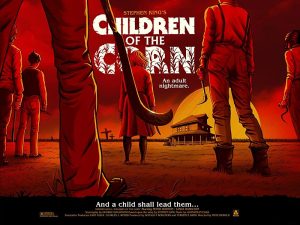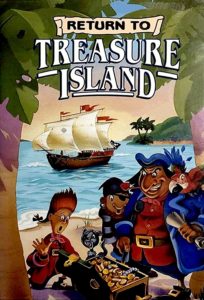 I’m not actually convinced I’ve never seen Children of the Corn before. But if I have, it made little enough impression on me that today’s viewing may as well have been the first. The funny thing is, I probably wouldn’t have bothered to watch it at all, but its sequel[1] wasn’t available on any streaming services, and the first one was, so, there you go.
I’m not actually convinced I’ve never seen Children of the Corn before. But if I have, it made little enough impression on me that today’s viewing may as well have been the first. The funny thing is, I probably wouldn’t have bothered to watch it at all, but its sequel[1] wasn’t available on any streaming services, and the first one was, so, there you go.
What I think would have made this a much better movie is if there had been no prologue. Like, keep all the same footage and use it later in flashback. But if you start off with Linda Hamilton and some guy named Burt[3] driving down a country road in Nebraska, and they hit a kid who it turns out had his throat slit before they ever hit him, and there are menacing “watcher” camera angles, and the audience has to figure out what’s going on along with them? That’s a pressure cooker!
That small but major correction is almost everything the movie really needs. Okay, some of the final act special effects are terrible, but it’s basically 40 years old, so, forgiven. Creepy kids menacing you with farm implements in the middle of nowhere, that covers basically everything my suburban adulthood needs to be scared.
Well, one additional correction, maybe less small, is that outside of the flashback sequence, almost nobody dies, and I feel like this should have been a bloodbath. Probably if they had gone the “what is even happening?” pressure cooker route, this would bother me less. But, they didn’t, and it turns out this is just not a very good movie when over half of it is teenagers chasing Burt and/or Linda Hamilton around an empty small town downtown district, while the pacing of the plot makes it impossible to believe either of them is in any real danger, most of the time.
Still, though, it does make me wonder if it was possible, as late as the early ’80s, for a town to just disappear and nobody noticed. Now: zero percent chance. But then… like, I mostly still don’t buy it, especially when they threw in the shot of the 900-something population sign. But if it was less than 200, and basically everyone who cared about anyone who lived in the town currently lived in the town with them, I guess it’s a possibility?
In conclusion, small towns from my childhood are weird.
[1] which I plan to watch because a podcast I want to listen to will treat me as though I don’t care about spoilers[2]
[2] There’s a certain inherent irony to this explanation, I know.
[3] Now there’s a name that’s fallen out of favor.
 The boy has been watching Cars practically nonstop for the past four months. (Six?) But I didn’t ever sit down and watch it myself until this week. Common wisdom is that it’s a ripoff of Doc Hollywood, which would be easier to comment on if I, uh, remembered almost anything about that movie. I mean, the broad strokes, yes, in that a hotshot racecar|doctor learns that small town life is worthwhile and also falls in love. But I think I should be able to speak at a little more depth than that, to confirm or deny.
The boy has been watching Cars practically nonstop for the past four months. (Six?) But I didn’t ever sit down and watch it myself until this week. Common wisdom is that it’s a ripoff of Doc Hollywood, which would be easier to comment on if I, uh, remembered almost anything about that movie. I mean, the broad strokes, yes, in that a hotshot racecar|doctor learns that small town life is worthwhile and also falls in love. But I think I should be able to speak at a little more depth than that, to confirm or deny.







